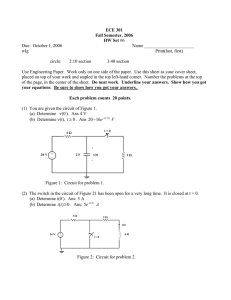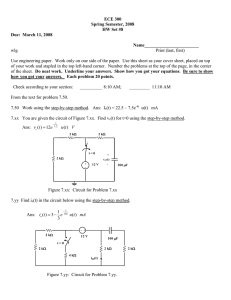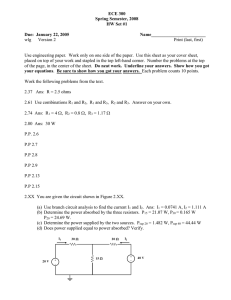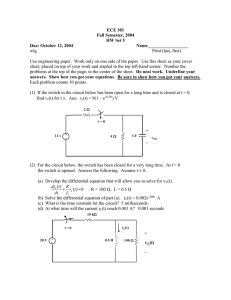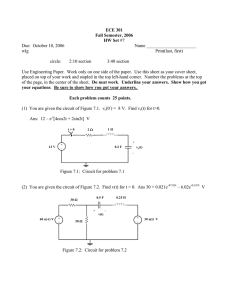ANS Audio Notification System Installation Sheet
advertisement
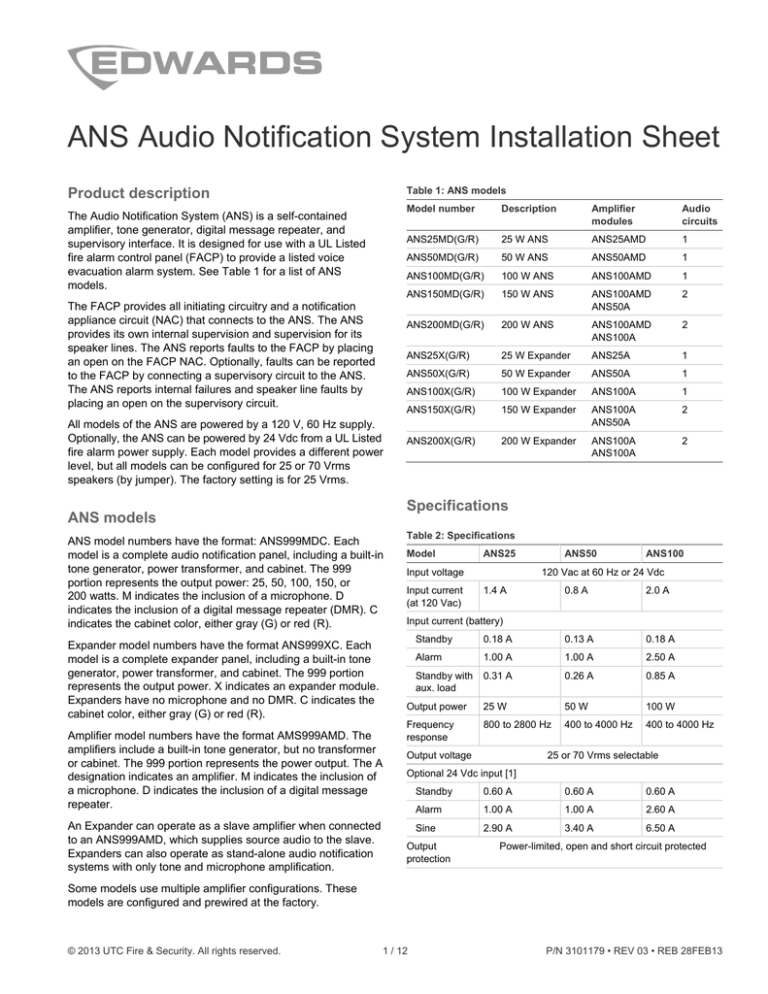
ANS Audio Notification System Installation Sheet Product description Table 1: ANS models The Audio Notification System (ANS) is a self-contained amplifier, tone generator, digital message repeater, and supervisory interface. It is designed for use with a UL Listed fire alarm control panel (FACP) to provide a listed voice evacuation alarm system. See Table 1 for a list of ANS models. The FACP provides all initiating circuitry and a notification appliance circuit (NAC) that connects to the ANS. The ANS provides its own internal supervision and supervision for its speaker lines. The ANS reports faults to the FACP by placing an open on the FACP NAC. Optionally, faults can be reported to the FACP by connecting a supervisory circuit to the ANS. The ANS reports internal failures and speaker line faults by placing an open on the supervisory circuit. All models of the ANS are powered by a 120 V, 60 Hz supply. Optionally, the ANS can be powered by 24 Vdc from a UL Listed fire alarm power supply. Each model provides a different power level, but all models can be configured for 25 or 70 Vrms speakers (by jumper). The factory setting is for 25 Vrms. Description Amplifier modules Audio circuits ANS25MD(G/R) 25 W ANS ANS25AMD 1 ANS50MD(G/R) 50 W ANS ANS50AMD 1 ANS100MD(G/R) 100 W ANS ANS100AMD 1 ANS150MD(G/R) 150 W ANS ANS100AMD ANS50A 2 ANS200MD(G/R) 200 W ANS ANS100AMD ANS100A 2 ANS25X(G/R) 25 W Expander ANS25A 1 ANS50X(G/R) 50 W Expander ANS50A 1 ANS100X(G/R) 100 W Expander ANS100A 1 ANS150X(G/R) 150 W Expander ANS100A ANS50A 2 ANS200X(G/R) 200 W Expander ANS100A ANS100A 2 Specifications ANS models ANS model numbers have the format: ANS999MDC. Each model is a complete audio notification panel, including a built-in tone generator, power transformer, and cabinet. The 999 portion represents the output power: 25, 50, 100, 150, or 200 watts. M indicates the inclusion of a microphone. D indicates the inclusion of a digital message repeater (DMR). C indicates the cabinet color, either gray (G) or red (R). Expander model numbers have the format ANS999XC. Each model is a complete expander panel, including a built-in tone generator, power transformer, and cabinet. The 999 portion represents the output power. X indicates an expander module. Expanders have no microphone and no DMR. C indicates the cabinet color, either gray (G) or red (R). Amplifier model numbers have the format AMS999AMD. The amplifiers include a built-in tone generator, but no transformer or cabinet. The 999 portion represents the power output. The A designation indicates an amplifier. M indicates the inclusion of a microphone. D indicates the inclusion of a digital message repeater. An Expander can operate as a slave amplifier when connected to an ANS999AMD, which supplies source audio to the slave. Expanders can also operate as stand-alone audio notification systems with only tone and microphone amplification. Model number Table 2: Specifications Model ANS25 Input voltage Input current (at 120 Vac) ANS50 ANS100 120 Vac at 60 Hz or 24 Vdc 1.4 A 0.8 A 2.0 A Input current (battery) Standby 0.18 A 0.13 A 0.18 A Alarm 1.00 A 1.00 A 2.50 A Standby with aux. load 0.31 A 0.26 A 0.85 A Output power 25 W 50 W 100 W Frequency response 800 to 2800 Hz 400 to 4000 Hz 400 to 4000 Hz Output voltage 25 or 70 Vrms selectable Optional 24 Vdc input [1] Standby 0.60 A 0.60 A 0.60 A Alarm 1.00 A 1.00 A 2.60 A Sine 2.90 A 3.40 A 6.50 A Output protection Power-limited, open and short circuit protected Some models use multiple amplifier configurations. These models are configured and prewired at the factory. © 2013 UTC Fire & Security. All rights reserved. 1 / 12 P/N 3101179 • REV 03 • REB 28FEB13 Model ANS25 ANS50 Note: if your system includes one or more ANSZS4B zone splitters, the FACP EOLR must be relocated. See the ANSZS4B installation sheet (P/N 3101185). ANS100 Battery charging capacity [2] Minimum Maximum 24 V, 7 Ah 24 V, 18 Ah FACP NAC circuit current 24 V, 18 Ah 24 V, 24 Ah 10 mA maximum [1] Input current measurements are determined using test conditions specified in UL 1711. Sine represents measurements made while the unit produces a continuous, undistorted sine wave of 1 kHz into the rated load of 25, 50, or 100 W at the rated output voltage. Alarm is the average current the unit experiences delivering an alarm signal, temporal whoop, to the rated load. Standby is the current draw of the unit with all normal power on and auxiliary terminals fully loaded. Battery standby is the current draw from the batteries on loss of power in an otherwise normal standby state. 4. Connect the FACP signaling circuit to TB1-3(+) and TB1-4(−), using the FACP alarm polarity. 5. Connect the mains power (120 Vac at 60 Hz) to the black and white pigtail leads from transformer primary. Secure the ground lead to the grounding stud in the cabinet. 6. Connect the battery wiring harness, Red(+) and Black(−). Observe the correct polarity. Use two 12 V batteries connected in series. (See Figure 4.) If the unit does not have its own batteries and relies on an external power supply with battery backup, ensure that switch SN2-7 is in the OFF position. [2] All ANS cabinets hold two 12 V, 7 Ah batteries. Larger batteries require an external battery cabinet. Note: Wiring for batteries is nonpower-limited. Maintain a minimum spacing of 1/4 in. between power-limited wiring and nonpower-limited wiring. Installation instructions If the batteries must be located in a separate enclosure, provide a separate conduit run for the battery wiring only. Ensure that all wiring and devices installed in the system meet the following standards: • • • • NFPA 70 National Electrical Code NFPA 72 National Fire Alarm and Signaling Code NFPA 101 Life Safety Code Applicable state and local codes Install this equipment in a clean, dry environment. Avoid installation where the equipment could be subjected to vibration. Remove all electronic assemblies from the enclosure before drilling or punching the enclosure. Where possible, make all cable entries from the rear or sides. Before making any modifications to the enclosure, be certain that they will not interfere with the assemblies or batteries. 3. Terminal designations Refer to Figure 1 for the locations of the terminals. Table 3: Terminal descriptions Description TB1-1, -2 Power input 24 to 32 Vac/Vdc [1][4] TB1-3, -4 FACP NAC input. 10 mA max. Alarm polarity is shown. [1][4] TB1-5, -6 Speaker loop, Style Y/Z (Class A/B start) [2][4] TB1-7, -8 Speaker loop Style Z (Class A return) [2][4] TB2-1 Circuit negative TB2-2 Aux audio input. 0.5 Vrms nominal, 1 Vrms, 1 mA max. [1][3] Be sure to observe polarity and connect all speakers using the same polarity. For Class A (Style Z) the returns are TB1-7(−) and TB1-8(+). TB2-3 Preamp in/out. 600 Ω, 0 dBm. [1][3][5] TB2-4 Factory Programmable output [1][3][5] TB2-5 Signal active [1][3][5] Note: When using 70 VRMS speakers, the speaker wiring must be enclosed in grounded metal conduit. TB2-6 Aux audio enable. +24 Vdc, 32 Vdc, 5 mA max. [1][3] TB2-7 Aux signal activate. +24 Vdc, 32 Vdc, 5 mA max. [1][3] Connect the microphone to connector P2. TB2-8 If the microphone is not installed, ensure that switch SN2-8 is in the OFF position. Alarm voltage. +24 Vdc, 0.1 A when unit is in alarm condition. [2][3][5] TB2-9 Attach the appropriate EOLR for the FACP to TB3-3 and 4 and for the speaker circuit to TB3-5 and 6. Interrupted V+. +24 Vdc, 0.1 A. Disconnected in alarm condition. [2][3] TB2-10 V+. +24 Vdc, 0.1 A. [2][3] You must use EOLR value specified for the FACP notification appliance circuit (NAC). See the FACP installation instructions provided by the manufacturer. TB2-11 Microphone PTT. +24 Vdc, 0.1 A. [5] TB3-1, -2 Optional FACP supervisory circuit. See installation instructions for details. 32 Vdc, 0.4 A max.). Must be configured using J1. [1][4] TB3-3, -4 FACP Signal/Supervisory circuit EOLR Refer to Figure 1 for terminal designations, and to diagrams in the “Applications” section for wiring diagrams. 2. When all power and circuits are connected, the green LED turns on (and stays on) to indicate that the ANS is fully operational and all circuits are normal. Terminal Wiring instructions 1. 7. Connect the speaker lines to TB1-5(+) and TB1-6(−). 2 / 12 P/N 3101179 • REV 03 • REB 28FEB13 Terminal Description MSG GAIN and MIC GAIN TB3-5, -6 Matching EOLR for speaker supervisory circuit TB3-7 General purpose output. Pulls to circuit negative on fault conditions. 32 Vdc, 0.2 A max. Not for fire protective signaling use. [1][3][5] The MSG GAIN (message gain) and MIC GAIN (microphone gain) potentiometers are factory set and should only be adjusted by trained technicians with the proper test equipment. TB3-8 Trouble input. +24 Vdc, 5 mA. [1][3][5] [1] Intended for connection to listed Class 2 or Class 3 (power-limited) sources only [2] Power-limited [3] Unsupervised [4] Supervised [5] Terminating equipment must be installed in the same room as the ANS To increase the output of a speaker, change the speaker tap connection or setting to a higher wattage. Switch S1 Pressing switch S1 performs a hard reset of the ANS microprocessor. This is not required during normal operation, and should only be done at the request of our support technicians. Figure 1: ANS features + – + – + – – + 1 2 3 4 5 6 7 8 DIP switch settings TB1 Factory settings TB2 J5 A B TB3 11 1 2 J1 10 1 2 4 5 6 7 8 Switch Setting Description 8 SN1-1 Off 8 second initial delay SN1-2 On 5 SN1-3 Off 4 SN1-4 On SN1-5 Off SN1-6 On Message on SN1-7 Off Three repeats SN1-8 On SN2-1 Off SN2-2 Off SN2-3 Off SN2-4 Off Fault code lock off SN2-5 Off Factory set. Do not change. SN2-6 Off AC fault delay SN2-7 On Battery connected SN2-8 On Microphone connected 6 1 2 3 70V 25V LED1 FAULT (yellow) LED2 NORMAL (green) 3 LED3 ALARM (red) 1 2 LED4 P2 MSG GND MIC GAIN FAULT GAIN (yellow) U6 SN2 Table 4: Factory DIP switch settings 9 7 J2 3 Refer to Figure 1 for DIP switch locations. The following table shows the factory settings and descriptions for the switches. 8 second repeat delay Temporal whoop signal SN1 S1 DIP switch detail OFF ON 1 2 3 4 5 6 7 8 P/N 3101179 • REV 03 • REB 28FEB13 3 / 12 Custom settings Jumper settings Table 5: Custom DIP switch settings Refer to Figure 1 for the locations of the jumpers. Table 6 shows the settings and descriptions for the jumpers. Switches Settings SN1-1/2/3 Sets the initial delay before the message starts to play. The tone sounds during this delay. There are eight options. Table 6: Jumper settings Jumper Setting Description Off | Off | Off = No delay On | Off | Off = 4 second delay Off | On | Off = 8 second delay On | On | Off = 12 second delay Off | Off | On = 16 second delay On | Off | On = 20 second delay Off | On | On = 24 second delay On | On | On = 28 second delay J1 (A and B) In No FACP supervision. See “Optional supervisory circuit” below J1 (A and B) Out FACP provides supervision. See “Optional supervisory circuit” below J2 1 to 2 70 Vrms speaker output J2 2 to 3 25 Vrms speaker output (factory setting) J5 In Ground fault detection enabled (factory setting) J5 Out Ground fault detection disabled SN1-4/5 SN1-6 Sets the delay between repetitions of the message. The tone sounds during this delay. There are four options. Off | Off = 4 second delay Off | On = 8 second delay On | Off = 12 second delay On | On = 16 second delay Options Sets the message play mode. There are two options. Terminals TB2-4, -8, -9, and -10 provide a maximum of 200 mA of regulated 24 Vdc power for auxiliary functions. Do not exceed a combined load of 200 mA on these terminals. These terminals are for connection to ANS accessory modules and listed general signal devices only and are not for use with fire protective signaling applications. Terminal TB2-4 activation is programmed in the U6 EPROM chip. Standard chips are programmed for TB2-4 to go active (+24 Vdc) under the following conditions: Off = Message off On = Message on SN1-7/8 Sets the number of times the message plays. There are four options. Off | Off = 1 play Off | On = 3 plays On | Off = 2 plays On | On = Continuous play SN2-1/2/3 Sets the evacuation tone. There are eight options. Off | Off | Off = Temporal slow whoop On | Off | Off = Hi-lo Off | On | Off = Horn On | On | Off = Bell Off | Off | On = None On | Off | On = Chime Off | On | On = None On | On | On = 1 kHz sine SN2-4 Sets the diagnostics mode. With diagnostics ON the last fault condition is displayed even if the fault is no longer present. There are two options. Off = Diagnostics off On = Diagnostics on SN2-5 Not used SN2-6 AC power failure report delay. There are two options. Off = No delay On = 6-hour delay SN2-7 Batteries. There are two options. Off = Batteries are not connected On = Batteries are connected SN2-8 Microphone. There are two options. Off = Microphone is not connected On = Microphone is connected 4 / 12 Aux +24 Vdc output • • • • Aux signal active Aux audio enable Bell circuit active RSI active Reprogramming of these functions must be done at the factory and requires replacing the EPROM U6. Aux audio source connection Terminals TB2-1 and -2 allow connection of an aux audio source from additional paging equipment to augment an existing paging system. This option is not intended for continuous signal input, but may be used for paging applications. For such an operation the aux audio enable input, TB2-6, must be powered from the interrupted V+, TB2-9. This ensures that in the event of an alarm, the aux audio will not override the evacuation signal. See Figure 9 for connection details. Use of an ANSAUX Audio Transponder Module may be required for some audio sources (to match the auxiliary audio line signal.) Optional supervisory circuit Terminals TB3-1 and -2 can be used to connect a supervisory circuit from the FACP to the ANS. In place of normal supervision via the notification appliance circuit, an alternate method may be employed using any supervisory circuit from the FACP. TB3-1 and -2 provide a normally closed connection to the EOLR on TB3-3 and -4. The relay contact in the circuit opens on any trouble condition and reports an open circuit trouble to the FACP. P/N 3101179 • REV 03 • REB 28FEB13 Note: To use this option, you must remove jumper shorting blocks A and B from J1. See Figure 7 for connection details. Expander installation The Expander is a self-contained amplifier, tone generator, power supply, and supervisory interface. It is designed to be used in conjunction with the ANS to provide additional speaker output power. An Expander can also be used as a stand-alone audio notification system, in conjunction with a fire alarm control panel, to provide voice evacuation where an automatic message is not desired. See Table 1 for a list of Expander model numbers and descriptions. Installation and operation of the Expander is identical to the ANS with the exception that no digital message is present. When used in conjunction with an ANS, the expander acts as a slave, reproducing the tone and message generated by the master. When used as a stand-alone system, the expander connects to the FACP exactly as the ANS does, to provide automatic tone in alarm and voice override capability with the microphone. Expander terminal designations and volume controls are identical to those for the ANS, but DIP switch configuration differs. The Expander has only one DIP switch, SN1. This determines tone, master/slave, battery, and microphone settings. The following table shows the settings and descriptions for switch SN1. Note that the factory settings are for slave configuration. Table 7: SN1 settings for master and slave Switch Master Slave Description SN1-1 Off Off Temporal whoop signal SN1-2 Off Off SN1-3 Off Off SN1-4 Off Off Not used SN1-5 Off Off Not used SN1-6 On Off Master / slave On = Master Off = Slave SN1-7 On On Batteries connected On = Yes Off = No SN1-8 On Off Microphone connected On = Yes Off = No Alarm audio: Alarm signal 5 seconds - digital message plays alarm signal 5 seconds - digital message plays - alarm signal 5 seconds - digital message plays - unit reverts to alarm signal until the alarm condition is cleared. If the microphone is keyed it will override both the tone and the message so a direct broadcast can be made. If this occurs during the initial sequence the digital message will be reset and will not play. When the microphone is keyed or when the message is played, the green LED dims. The intensity of the green LED varies with the level of the broadcast audio. This is true in alarm state as well. When the ANS is in a fault state, the yellow LED turns on and stays on. The green LED flashes. The flashes are coded so as to indicate the specific type of fault. When there is a fault condition, the contact connecting the FACP signal circuit to the EOLR opens, indicating the fault to the panel, which then provides annunciation. During a ground fault condition, the second yellow LED (LED4) turns on. Trouble codes When the ANS enters the trouble state, the yellow LED turns on and stays on until the trouble is cleared. The green LED flashes, using a code to indicate the specific type of fault. This code repeats with a pause between repetitions. When multiple trouble conditions occur at the same time, the codes are added together. The number of flashes and the associated trouble conditions are listed below. Table 8: Trouble codes Code Trouble 1 Power failure 2 Open speaker circuit 4 Shorted speaker circuit 6 [1] External trouble / ground fault 8 Amplifier trouble 16 Microphone trouble 32 Battery trouble [1] 6 flashes typically indicates an external trouble (such as trouble with an ANSREM). However, when LED 4 is also on, 6 flashes indicates a ground fault. If both a ground fault condition and an external trouble occur simultaneously, the fault codes do not combine to create a 12-flash code. Operation When the ANS is in normal (standby) state, the green LED stays on. When the ANS is in an alarm state, the red LED turns on and stays on as long as the unit is in alarm. The green LED also stays on in the alarm state. When using the factory settings, operation is as follows. P/N 3101179 • REV 03 • REB 28FEB13 5 / 12 End of line resistors Figure 2: Details of the EOLRs used by the ANS R3 SPEAKER EOLR FACP NAC R3: End of line resistor for the speaker circuit. [2] Note: These connections are internal. Do not make these connections. 4 5 3 Notes 6 [1] If the Fire Alarm Signal Circuit requires a 4.7 kΩ end-of-line resistor, then R1 must be 4.7 kΩ. Normally, this resistor is connected to the Signal Circuit through a closed Trouble contact. When the EVAX 25/50 goes into Trouble, the contact opens, producing an "open" on that Signal Circuit, notifying the FACP. [2] R2 and R3 must match each other. R2 "sets" what the value of R3 needs to be. R2 tells the EVAX 25/50 what to expect on the end of the Speaker Circuit. If a Speaker EOLR (R3) already exists, simply match that value for R2. The allowed range of values is 2.2 kO to 100 kO. [3] Do not connect notification appliances between TB2-3 and 4 and R1. Attaching notification appliances to these terminals damages the ANS. R1: End-of-line resistor for FACP signal circuit. [1] [3] R1 FACP EOLR 3 4 5 SET EOLR 6 R2 R2: Sets the value of the end-of-line resistor for the speaker circuit. [2] Applications Cabinet layout Figure 3: Cabinet layout showing wire routing Input power connection is nonpower-limited. Do not route any power-limited wiring within 1/4 in. of the input power cabling. All wiring from terminal blocks is power-limited. Use a knockout at the top or side of the cabinet for wire routing. XFMR 1 2 3 4 5 6 7 8 TB1 1 2 3 4 5 6 7 8 TB3 TB2 11 10 9 8 7 6 5 4 3 2 1 Battery cabling is Nonpowerlimited. Do not route any power-limited wiring within 1/4 in. of the battery cabling. 12 V 7 Ah Battery 6 / 12 12 V 7 Ah Battery P/N 3101179 • REV 03 • REB 28FEB13 Typical installation Figure 4: Typical installation with an FACP NAC circuit dedicated FIRE ALARM CONTROL PANEL Supervised and power-limited E O L NAC CLASS B (Style Y) WIRING Supervised and power-limited Polarity shown in alarm Standard life safety speakers or speaker-strobes. (Strobe circuit wiring is not shown.) Break the wire at all speaker terminals to maintain supervision. Do not loop the wire around the terminals XFMR Supervised and power-limited INPUT POWER (120 Vac) + – + – + – – + 1 2 3 4 5 6 7 8 TB1 Supervised and nonpower-limited CLASS A (Style Z) WIRING TB2 J5 A B TB3 11 1 2 J1 10 9 1 8 2 FACP EOLR MATCHING EOLR (SPEAKER CIRCUIT) E O L E O L 5 6 7 8 7 J2 3 4 EOLR 6 5 1 2 3 70V 25V LED1 FAULT (yellow) LED2 NORMAL (green) 3 LED3 ALARM (red) 1 4 2 EOL LED4 TB1 P2 MSG GND MIC GAIN FAULT GAIN (yellow) 5 6 7 8 Supervised and power-limited U6 SN2 SN1 S1 Black - - Battery wire harness Charging current = 1 A max. Supervised and nonpower-limited P/N 3101179 • REV 03 • REB 28FEB13 12 V Battery 12 V Battery + Red + (Jumper wire provided) 7 / 12 Addressable systems Figure 5: Wiring for an addressable system using a riser module or notification appliance circuit module RISER IN 24 Vdc 0.01 A max. Supervised and power-limited Power and speaker connections remain unchanged ADDRESSABLE RISER/NAC MODULE CLOSES FOR ALARM ACTIVATION Power and speaker connections remain unchanged ADDRESSABLE LOOP + – + – + – + – 1 2 3 4 5 6 7 8 TB1 Addressable Modules must be located within 20 ft. and interconnection must be in a conduit. TB2 J5 A B TB3 11 1 2 J1 10 9 1 8 2 MODULE EOLR MATCHING EOLR (MODULE-SPEAKER CIRCUIT) E O L E O L 7 J2 3 4 6 5 1 2 3 70V 25V 5 6 4 3 7 2 8 1 P2 U6 SN2 SN1 S1 8 / 12 P/N 3101179 • REV 03 • REB 28FEB13 Figure 6: Wiring for an addressable system using a relay module to activate the ANS and a monitor module for supervision ADDRESSABLE CONTROL MODULE 24 Vdc 0.01 A max. NO Unsupervised and power-limited CLOSES FOR ALARM ACTIVATION ADDRESSABLE LOOP Addressable Modules must be located within 20 ft. and interconnection must be in a conduit. [2] [2] + – + – + – – + 1 2 3 4 5 6 7 8 TB1 ADDRESSABLE MONITOR MODULE TB2 J5 TB3 Supervised and power-limited MONITOR MODULE EOLR MATCHING EOLR (SPEAKER CIRCUIT) A B E O L E O L 11 1 2 J1 [1] 10 9 1 8 2 7 J2 3 4 6 5 1 2 3 70V 25V 5 6 4 3 7 2 8 1 P2 Notes [1] [2] The jumper shorting blocks on J1 must be removed for this application. U6 Power and speaker connections remain unchanged. SN2 SN1 S1 P/N 3101179 • REV 03 • REB 28FEB13 9 / 12 Optional supervisory circuit Note: We recommend that you connect the ANS to a dedicated NAC circuit using the wiring methods shown in Figure 4, Figure 5, or Figure 6. Failure to do so may cause down-line devices to be disabled in the event of some ANS fault conditions. Figure 7: Using an FACP supervisory circuit FIRE ALARM CONTROL PANEL NAC Supervised and power-limited TO Next Device or EOLR ALARM POLARITY [2] [2] + – 1 2 + – 3 4 + – – + 5 6 7 8 TB1 FIRE ALARM CONTROL PANEL TB2 J5 A B TB3 11 1 2 J1 [1] 10 9 1 TROUBLE ZONE 8 2 ZONE EOLR MATCHING EOLR (SPEAKER CIRCUIT) E O L E O L 7 J2 3 4 6 5 1 2 3 70V 25V 5 6 4 3 7 2 8 1 P2 Notes [1] The jumper shorting blocks on J1 must be removed for this application. [2] Power and speaker connections remain unchanged. 10 / 12 U6 SN2 SN1 S1 P/N 3101179 • REV 03 • REB 28FEB13 Multiple unit connection Figure 8: Wiring an Expander to a primary ANS Unsupervised and power-limited TO ADDITIONAL EXPANDER UNITS [1] + – – + + – – + + – + – + – – + 1 2 3 4 5 6 7 8 TB1 TB1 1 2 4 3 5 7 6 8 TB2 A B 10 9 TB3 1 8 1 2 7 2 6 3 5 4 4 5 3 6 2 7 1 8 TB3 J2 3 4 5 6 7 8 LED1 FAULT (yellow) LED2 NORMAL (green) LED3 ALARM (red) 1 2 3 P2 MSG GAIN A B 11 1 2 J1 10 9 8 7 J2 LED1 FAULT (yellow) LED2 NORMAL (green) LED3 ALARM (red) 6 5 1 2 3 70V 25V 4 3 2 1 LED4 MSG GND MIC GAIN FAULT GAIN (yellow) MIC GAIN ANS25X, ANS50X, ANS100X TB2 J5 11 J1 P2 A 14-pin ribbon cable (factory supplied) can be used in place of hard-wired connections. U6 SN2 SN1 [2] S1 SN1 S1 Notes [1] The maximum number of units that can be cascaded is 15. [2] Switch SN1-8 must be OFF for all units with no microphone. 3. All power, supervisory and speaker connections remain unchanged. 4. The modules must be in the same cabinet, or must be located within 20 ft. and use conduit for interconnections. P/N 3101179 • REV 03 • REB 28FEB13 11 / 12 Aux audio enable connection Figure 9: Wiring for aux audio + – + – + – – + 1 2 3 4 5 6 7 8 TB1 TB2 J5 A B TB3 J1 10 9 1 8 2 7 J2 3 4 5 6 7 8 NO dry contact (customer-provided) 11 1 2 6 5 1 2 3 70V 25V LED1 FAULT (yellow) LED2 NORMAL (green) 3 LED3 ALARM (red) 1 Interupted V+ Aux audio enable 4 2 Aux audio input [1] LED4 P2 MSG GND MIC GAIN FAULT GAIN (yellow) U6 SN2 SN1 S1 Notes 12 / 12 [1] Aux audio input: 0.5 Vrms nominal, 1 Vrms, 1 mA max. 2. For additional input options or VOX activation an ANSAUX module must be used P/N 3101179 • REV 03 • REB 28FEB13
